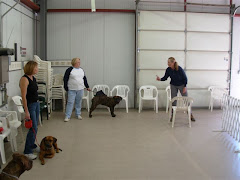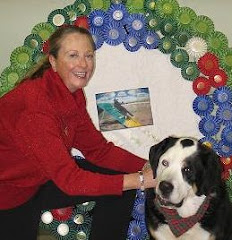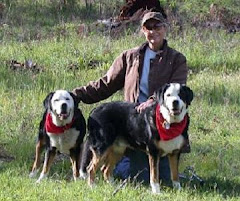Photos: Winston, a Yorkie (little dogs do it too), and the Gregory boys, Duncan and Tanner (down-stays are also great for photos!)
My husband and I are still living in a crate with three large dogs. Actually, it's a 28-foot trailer next to the new home that's not quite completed yet. There's hardly room for us to walk around each other in here, and virtually no room for dogs to play or argue. Old Atlas and Kosmo frequently get into "yelling contests" (Greater Swiss Mountain Dogs are NOISY dogs!), which can give Atlas indigestion. Me too, but with Atlas it can be a life-and-death issue at this point, because his indigestion can lead to bloat. So we've reinstated the "Down-stay" rule. Whenever we're preparing their meals, or whenever we're eating, or whenever things start getting too exciting for whatever reason, all three dogs have to do "down-stays." It's like a sedative for all of them, because they know that when we say it, we're going to make it happen.
"Down-stay" is the command that can bring sanity back to your household, and safety to your dog. Use it...not as punishment, but as employment for your dog.
When you say "Down," and then add "Stay" to it, you are telling your dog to lie down immediately and to stay in that position until released. Period. To do a good down-stay, we must assume the dog knows first what "Stay" means. He can't know it unless you've systematically taught it to him. Generally we teach dogs to "stay" in a "sit" position first, because it's more demanding. That is, it lets us more precisely teach the dog the "stay" concept if he is in a sitting position rather than a "down" or a "stand." If your dog doesn't know the positions yet, no problem. You can PUT the dog in the position, and then work on the "STAY." He'll get it. He'll figure out that "STAY" is applicable to ANY position he is in when you say it.
Once your dog has grasped the concept of a "sit-stay," you can place him in the "down" position and teach him to "stay" in that position too. Simply wait for him to start to get up on his own, and when he does, step in and correct him. Tell him "No! Down. STAYYYYY." Correct with a sharp, quick, authoritative snap of the leash or collar straight downward (not sideways or back) so the dog goes directly to the floor as if an anchor is around his collar. DO NOT PRAISE OR PET THE DOG....YET. Wait at least a few seconds, or even a minute before you praise the dog for what he is doing. "Good down-stay!" Your job-specific praise will make it pleasurable for him to perform his task, and will reduce his stress level, making it easier for him to concentrate on his job. CAUTION: If you praise too exuberantly, or with too much body language, your dog will get up...which means you'll have to correct him again. Don't sabotage your dog's good work with body language or excited praise that confuses him about what you want.
There is no time limit on a down-stay. It's a resting position for your dog, and it's the one in which he spend about 75% of his life. So you're not asking your dog for anything difficult or uncomfortable. Just be ready to correct EVERY time your dog thinks about getting up...until he gives up and decides to relax and accept your demand.
Little dogs can and should do down-stays too, providing they are in a safe place (i.e., not likely to be attacked by a monster jumping out of the bushes or closet). You'll notice your little dog will probably get the "shakes" (trembles) while first doing an enforced down-stay. He is neither cold nor traumatized, so you need not worry. He's just showing his stress more visibly than a larger dog might. If you are imposing the down-stay in a safe situation, he will come to terms with it and be less stressed (and more trusting of you) in future situations.
The "down-stay" MUST end with an official release command from you. Most people use "Okay!" to let the dogs know they can get up at that point. Whatever you use, practice using the same tone of voice...generally a happy, upbeat voice. If the dog doesn't immediately respond to your "Okay," pick up his leash, clap your hands, or do something else friendly and exciting to signal your dog that the pressure is off. Now have a few seconds of fun with your dog to show your appreciation of him.
The "down-stay" is your dog's ticket into society. With this command, your dog can go almost anywhere with you...to work, concerts, appointments, shopping, meetings. You can also entertain dinner guests at your home without banishing the dog from the area. While you eat, the dog does a down-stay next to your chair. There's nowhere he'd rather be than safely parked next to you...and he doesn't need any table scraps to enjoy it!


















No comments:
Post a Comment